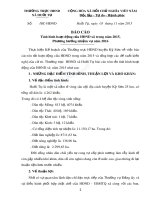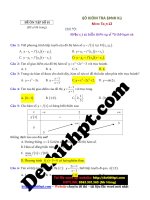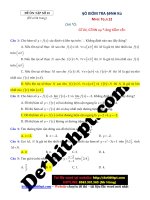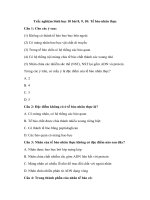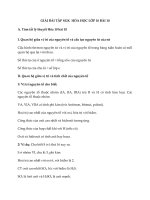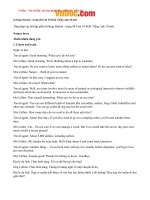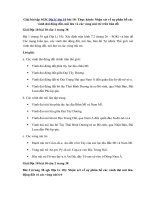Đề số 01 kiểm tra vào 10
Bạn đang xem bản rút gọn của tài liệu. Xem và tải ngay bản đầy đủ của tài liệu tại đây (105.8 KB, 4 trang )
SỞ GIÁO DỤC VÀ ĐÀO TẠO HẢI PHÒNG
CỘNG HÒA XÃ HỘI CHỦ NGHĨA VIỆT NAM
HỘI ĐỒNG KHẢO SÁT CHẤT LƯỢNG
Độc lập – Tự do – Hạnh phúc
KỲ THI TUYỂN SINH VÀO 10 NĂM HOC 2022 – 2023 ĐỀ SỐ 1
MÔN TIẾNG ANH LỚP 9
Thời gian : 45 phút
Đề thi : gồm 2 trang giấy
HỌ VÀ TÊN : ............................................................................ ĐIỂM : .............................
MÃ ĐỀ THI : 101
Read the following passage and mark the letter A, B, C or D to indicate the correct answer to each of the question
For formal ceremonies, men would have two additional items, a long gown with slits on either side, and a turban,
usually in black or brown made of cotton or silk. In feudal times, there were strict dress codes. Ordinary people
were not allowed to wear clothes with dyes rather than black, brown or white. Costumes in yellow were reserved for
the King. Those in purple and red were reserved for high ranking court officials, while dresses in blue were
exclusively worn by petty court officials. Men’s dress has gradually changed along with social development.
The traditional set of a long gown and turban gave way to modern-looking suits, while business shirts and trousers
have replaced traditional long sleeved shirts and wide trousers. Traditional costumes still exist and efforts are
increasingly being made to restore traditional festivals and entertainment which incorporate traditional costumes.
For women, the outer garment is a special silk gown called an “ao tu than” which is brown or light brown in colour
with four slits divided equally on its lower section. The second layer is a pink gown. When a woman wears her three
gowns, she fastens the buttons on the side, and leave those on the chest unfastened so that it forms a shaped collar.
This allows her to show the different colors on the upper part of the three gowns. Today, on formal occasions
women wear “ao dai”.
Question 1. In the past, the colour was used to represent _______.
A. the difference between men and women
C. the social development
B. formal ceremonies
D. the rank in the society
Question 2. In the past, for formal ceremonies men wore _______.
A. costumes in purple or yellow not like the King
C. costumes made of red cotton or silk
B. a long gown and a turban in black or brown
D. dresses in blue as petty court officials
Question 3. Traditional festivals _______.
A. promote traditional costumes
C. replace traditional suits by business ones
B. encourage modern-looking suits
D. make men’s dresses change
Question 4. All of the following are true about women’s traditional costumes EXCEPT that _______.
A. the gowns have different colours on the upper part
B. we can see a shaped collar in the front
C. the two inner gowns cannot be seen
D. the outer gown has four equal parts on its lower section
Question 5. The word “gown” in paragraph 1 is closest in meaning to _______.
A. a long dress worn on formal occasions
C. a long piece of clothing worn by judges
B. a woman’s dress, especially a long one
D. a piece of clothing worn over other clothes to protect
Mã đề thi 101 – Trang 1/2
Question 6. Mark the letter A, B, C or D to indicate the most suitable response to complete each of the following
exchanges
A: “I’m afraid I can’t come to your house-warming party next Saturday.
B: “...................................”
A. That sounds fun.
B. Oh, what a pity!
C. That’s ridiculous.
D. Oh, what a relief!
Question 7. Choose the correct answer A, B, C or D
I don’t think that burning garage is a good way to.................................environment.
A. protect
B. pollute
C. keep
D. reuse
Question 8. Mark the letter A, B, C, or D on your answer sheet to indicate the sentence that is closest in
meaning to each of the following questions: “Let’s break for lunch,” said Mathew.
A. Mathew wanted to break for lunch.
B. Mathew insisted on breaking for lunch.
C. Mathew suggested breaking for lunch.
D. Mathew offered US a break for lunch.
Question 9. Mark the letter A, B, C, or D on your answer sheet to indicate the sentence that is closest in
meaning to each of the following questions: They declared that she won the competition.
A. It is declared that she won the competition.
B. It was declared that she won the competition.
C. She was declared that she won the competition.
D. She is declared that she won the competition
Question 10. Mark the letter A, B, C, or D on your answer sheet to indicate the sentence that is closest in
meaning to each of the following questions: What a pity I didn’t meet you yesterday.
A. If only I met you yesterday.
B. If only I meet you yesterday.
C. If only I had met you yesterday
D. If only I hadn’t met you yesterday.
Read the following passage and mark the letter A, B, C or D to indicate the correct word or phrase that best fits of
each of the numbered blanks
Revising for exams is not as easy as it looks. You will need to work out with routine which suits you best, and often
stick to it. Some people like studying at night when it’s (11)........, whereas others find the early morning is a good
time to get things done. You might enjoy listening to music while you revise, but this can be (12)_______. Can you
really concentrate on two things at one time? So think (13) .........you turn your radio on!
Question 11.
A. quiet
Question 12.
A. interesting
Question 13.
A. unless
B. cool
C. peace
D. sleepy
B. unhelpful
C. comfortable
D. unhealthy
B. if
C. before
D. after
Question 14. Choose the correct answer A, B, C or D
Ringgit is the unit of ……………. in Malaysia.
A. currency
B. language
C. money
D. lesson
Question 15. Mark the letter A, B, C or D to indicate the word that differs from the other three in the position
of primary stress in each of the following questions
A. mission
B. career
C. rusty
D. accent
Question 16. Choose the correct answer A, B, C or D
Would you like …………. and visit my country?
A. Come
B. coming
C. to come
D. Came
Question 17. Mark the letter A, B, C or D to indicate the word whose underlined part differs from the other
three in pronunciation in each of the following questions
A. measures
B. cadges
C. searches
D. edges
Mã đề thi 101 – Trang 2/2
Question 18. Choose the correct answer A, B, C or D
The students used …………. football in that stadium, but now they don’t.
A. playing
B. to play
C. played
D. play
Question 19. Choose the correct answer A, B, C or D
Thu and Lan …………. Pen pals for over 5 years.
A. were
B. haven’t
C. are
D. have been
Question 20. Mark the letter A, B, C or D to indicate the word whose underlined part differs from the other
three in pronunciation in each of the following questions
A. shout
B. amount
C. about
D. should
Question 21. Choose the correct answer A, B, C or D
The teacher stands ...........the class.
A. under
B. at
C. from
D. in front of
Question 22. Choose the correct answer A, B, C or D
You must learn English at school. It’s a…………..….. subject.
A. National
B. second
C. Primary
D. compulsory
Question 23. Choose the correct answer A, B, C or D
He wishes he ……………. around the world.
A. travels
B. Can travel
C. Traveling
D. could travel
Question 24. Mark the letter A, B, C or D to indicate the word that differs from the other three in the position
of primary stress in each of the following questions
A. versatile
B. financial
C. housekeeper
D. openness
Question 25. Mark the letter A, B, C or D to indicate the word(s) OPPOSITE in meaning to the underlined word(s)
in each of the following questions.
Students are advised to tune out distractions and focus on study.
A. avoid
B. forget
C. neglect
D. regard
----------------------------- THE END --------------------------Đáp án
Đề\câu
1
2
3
4
5
6
7
8
101
D
B
A
C
A
B
A
C
Mã đề thi 101 – Trang 3/2
9
10
11
12
13
14
15
16
17
18
19
20
21
22
23
24
25
B
C
A
B
A
A
B
C
A
B
D
D
D
D
D
B
C
Mã đề thi 101 – Trang 4/2
